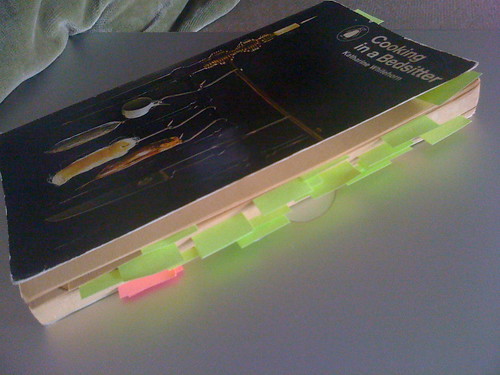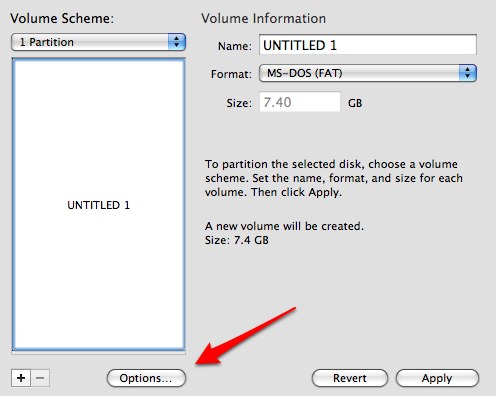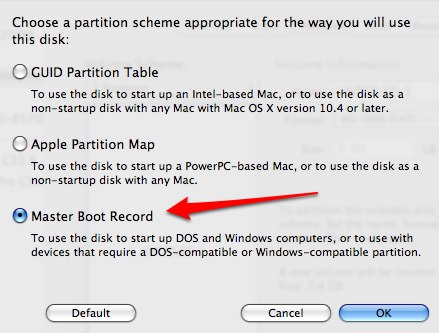
When I moved house recently, I managed to find my copy of Katharine Whitehorn‘s classic Cooking In A Bedsitter. Almost everyone I’ve shown it to has loved it, and asked for me to put more of it online, and so Easter Weekend seemed as good a time as any to dog-ear some pages.
Whitehorn’s book was first published in 1961, and targets the early twenty-somethings moving into small bedsits with the advent of first jobs; her goal is to point out that you can cook perfectly well – even rather entertainingly – with a single gas ring and no sink, but you’re not going to be cooking like mother – and you’re going to have to be a little bit creative.
What follows is a selection of simple, cost-conscious and clearly explained recipes for the first-time bedsitter cook. They are accompanied by Whitehorn’s barbed tongue and voice of expertise, although she barely lived in a bedsit, and didn’t really enjoy cooking, as this interview with Rachel Cooke from last year’s Observer details.
There are two sections to the book. The first, “Cooking To Stay Alive” is a crash course in cookery, storage, inventive use of space and savvy cooking. The second, “Cooking To Impress”, looks at how to cook for parties or groups or, most importantly of all, objects of affection. It’s here that Whitehorn’s pragmatism combines with a saucy barb and, frankly, makes me laugh very hard.
Anyhow, it was hard not to copy out the whole book, but I’ve tried to be reserved to give you an idea of what you’re missing. Do buy the book – it’s still in print, although without the delightful cover of the Penguin edition – if only for a slice of cultural history, when bedsits weren’t last resorts and we were still learning what to do with tinned food. Also, because it’s funny, as I hope you’ll see. I’ve tried to not quote the recipes as much as the text, if only to make it worth your while buying it.
p.13, introducing the notion of cooking in a bedsitter:
“it is a sad fact that the better the room itself and the house in which it is found, the worse the cooking problem tends to be. In a large squalid rooming house, where the landlord calls only to collect the rent and where the cleaning, if any, is done by an indifferent slut with no standards to maintained, adventurous cooking is perfectly possible… if you fill the whole house with the smell of burning onions you will be cursed but not evicted; and nothing will look much worse whatever you spill on it”.
p.14
“it is a common fallacy among the better class of landladies that one can exist entirely on tea, biscuits, and good books, without the need for food, beer, the wireless, or the companionship of the opposite sex”
“plenty of our troubles are of our own making. So many of us go into bedsitters, at least in the first instance, with the attitude of ‘me all alone in my little room with my little pan and my little spoon’ – and small pans, of course, make things ten times harder when you have only the one ring on which to cook everything you want to eat. Much better to think ‘me with my enormous appetite and my huge stewpan’.”
p.15, on learning to think like a bedsitter cook:
“The first thing a bedsitter cook must do is abandon the notion of ‘meat and two veg’, in favour of the idea of a simmering cauldron. Meat, yes; vegetables, certainly – thought it might be one or it might be four – but meat and vegetables deliberately chosen to be cooked together, so that the dish is all the better for one food sharing its flavours with another. And that brings us, inevitably, to the casserole.”
p.19, on arranging the room:
“You can save yourself a lot of trouble by deciding that one corner of the room is to be wholely given over to food. College girls who hide their cosmetics in their desks usually look as if they didn’t bother about their faces; by the same token, if you care about food, don’t hide it.”
p.20, explaining just what you really need to run a small kitchen:
“A good many cookery books start out by requiring a vast battery of equipment without which the simplest dish is doomed to failure. (I always burst into tears when I get to the bit about the little porcelain ramekins). But here it is not a question of the best possible tools, but the fewest… the right simple tools will stop you longing for the other, complicated ones.”
p.51, an early recipe illustrating just how simple some of the recipes are – and just how basic the ingredients:
Sausage and Smash
4 pork or beef sausages
a little fat
1 tin condensed vegetable soup
Fry sausages over medium flame 10 minutes; pour contents of tin into pan, and stir until heated, 3-4 minutes.
p.55, a recipe from the rather creative section on what you can do with bacon:
Dixie Casserole
2/3 rashers bacon
1 small tin sweetcorn
2 eggs (optional)
1 dessertspoon flour
1 cup milk or less
First hard-boil eggs if you are using them. Then fry bacon until crisp; pour off fat till about a tablespoon remains. Add flour, over gentle heat, till fat is absorbed. Add liquid from tin, gradually, and then milk until you have added one cup in all. Stir until it thickens; add corn, bacon, and halved hard-boiled eggs. Simmmer 10 minutes.
p.63, introducing the section on vegetables:
“If meat costs 3s. 6d. a pound we think it cheap; if vegetables cost 3s. 56d a pound, we think them dear. Moral: eat vegetables.”
p.79, introducing the section on Beef:
“Most cookery books begin with the portrait, in profile, of the Planned Cow. This amiable beast is covered with dotted lines, like a map; and the idea is to show the uninitiated where their piece of beef should come from. I am sorry to deny my readers this pretty sight. But the trouble with the Planned Cow is that it looks so totally unlike the nameless red hunks that actually appear on the butcher’s slab. It is really more use to know what it looks like when you buy it than to know what it looked like when it was somebody’s mother (or son).”
p.100, on curry:
“Curry finds itself in this section because it is useless to try to impress anyone with a curry nowadays unless you have spent several years out East and are prepared to talk about it, as well as cook, for hours on end. When it comes to really elaborate curries it is much better to be on the receiving end, and fortunately most people who live in bedsitters know at least one Indian or Pakistani who is delighted to make a curry for an admiring friend. moreover, they are apt to know their proportions only in terms of .01 grains of saffron per half sheep, so that they will often make enough curry for you and everyone on the staircase to feed off for a week.”
p.143, introducing “Cooking to Impress”:
“Impressing visitors can usually be done in two ways: the Lavish and the Casual. For you in your bedsitter the lavish is impossible… instead you must concentrate on the apparently effortless meal – the attitude of ‘just a little thing I seem to have cooking in this pot’… if your guests are not to see you looking flustered over your cooking, this in practice means they had better not see you cooking at all.”
p.145, outlining a few important things to do first:
“3. Get yourself looking nice. In a house you can disappear and finish dressing – in a bedsitter, no. Besides, you want your friends to think that dark-eyed look is all Soul, not just mascara; and they won’t, if they see you putting it on.”
p.147 – “Who Are You Trying To Impress?”. Visitors come in four categories:
“1. The troglodyte in the next bedsitter.
2. Couples, or mixed singles, who are accustomed to kitchen food and drawing-room standards. They have forgotten what it was like to cook in a bedsitter (if they ever knew), and it is your business not to remind them.
3. Your parents, or your parents’ spies – who are there to reassure themselves that you are eating adequately, get to bed early, know no vicious young men, and breath plenty of clean fresh air.
4. Delicious little parties à deux.”
p.148 – Cooking for a Man:
“Elementary rules: avoid all whimsy and complication in the food.”
and later on:
“Don’t apologize much if anything goes wrong; don’t flap, whatever happens, and NEVER ask ‘Is it all right?'”
“Ah,” said a friend when I showed them that section; “that sounds a lot like sex.”
Of course, the elementary techniques described do not always apply:
“There is one class of man for whom a quite different routine is needed: the richie who has up till now bought you expensive meals in smart places – often your only decent meal that week – and now, to your horror, wants to get to know you better in your own surrounds. You don’t want him to think that you can’t be bothered to cook for him, or can’t stand him around the place, or else he will naturally never ask you out again. But equally, neither the food nor the atmosphere must be so inviting that he decides to give up eating out altogether in favour of eating in. The dodge here is to reverse the normal procedure, and fuss up and down constantly… he will quickly conclude that your own surroundings hold little promise for him, and go back to taking you to Boulestin’s, or of course luring you back to his own lush flat. Well, at least he has to see to the food there.”
p.149 – Cooking for a Girl is somewhat different, Whitehorn explains:
“You, as a man, can get away with more roughness than a girl can. But if you are seriously luring the girl, you have a dilemma: you certainly don’t want to give her the idea that you are struggling to impress her, but of course she will be touched and appreciative of any sign that shows you have remembered who it is you are feeding. The right compromise is to imply that you set yourself rather high standards of food; but add, almost as an afterthought, something of purely feminie appeal, like sticky chocolates or her own special brand of Turkish cigarettes.”
p.173 – The final chapter, on “Drink And Parties”, was “contributed by a man” – specifically, Whitehorn’s husband, Gavin Lyall.
“It should be news to no one that red wine goes with red meat and most game; white wine with fish, veal, and the sweet courses. More to the point, perhaps, is that white wine goes with carpets; red wine only with floors you can wipe clean or don’t need to care about.”
p.175, on Parties:
“There are only two rules for parties: the carpet rule redoubled in spades, and don’t mix the drinks.”
p.177, on serving Spirits:
“Spirits cost money. Pubs reckon getting 32 measure from one bottle (so you can work out a rough idea of their gross profit), but I shouldn’t go giving your friends pub-sized measures if you want them to stay friends.”
p.178
“There is nothing against having beer for the men and gin for the women – if you can keep the men away from the gin.”
As I said earlier; it’s a wonderful book, and the recipes in it vary from useful, fast snacks to ingenious dishes that might well become staples in time. And it’s worth it just for Whitehorn’s wonderful, barbed tongue.




